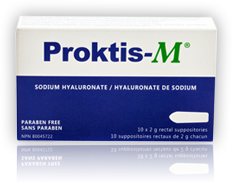
Hemorrhoids (often described as “varicose veins of the anus and rectum”) are inflamed, bulging veins in and near the anus and rectum. There are two types: internal hemorrhoids (inside), which develop below the lining of the lower rectum, and external hemorrhoids (outside) which develop beneath the skin around the anus.
Some research estimates that 75% of people will experience some degree of hemorrhoids during their lifetime. Hemorrhoids affect both men and women, and while most cases are present in those between 45 and 65 years of age, hemorrhoids can affect people of all ages.
Internal hemorrhoids are classified in grades by their degree of prolapse (internal tissue that protrudes from the anal opening to the outside of the anus and can be seen/felt during a bowel movement or when cleaning/wiping):
- Grade I – No prolapse;
- Grade II – Prolapse spontaneously reverts back inside the anus;
- Grade III – Prolapse can be gently pushed back inside the anus by the patient;
- Grade IV – Prolapse cannot be pushed back inside the anus by the patient as it is too painful.
Proktis-M® is a safe, tried and tested hemorrhoids treatment that has helped men and women for 15 years.
Shop Online
Causes and Risk Factors
Hemorrhoids can be caused by increased pressure in the abdomen which causes veins near the anus and rectum to swell. This kind of pressure can be caused by:
- Chronic constipation or diarrhea;
- Straining during defecation (this may cause a prolapsed hemorrhoid);
- Pregnancy and childbirth;
- Irregular bowel movement patterns;
- Sitting on the toilet for long periods;
- Obesity;
- Low-fiber diet;
- Anal intercourse.
Symptoms
The symptoms of internal hemorrhoids vary from person-to-person, but most commonly include rectal bleeding (typically painless) and protrusion of the hemorrhoid during bowel movements. If completely prolapsed, hemorrhoids can cause severe pain and often cannot be pushed back inside by the patient.
In addition to prolapsed hemorrhoidal tissue, a person may also experience:
- Bleeding after a bowel movement (bright red blood may be found on toilet paper, dripping into the toilet, or within the stool);
- Significant anal itching and irritation;
- Discomfort (feeling of stool being “stuck” at the anus);
- Leakage of feces;
- Mucous discharge.
Prevention
Regulating bowel movements through a diet containing fiber-rich foods, a fiber supplement and/or increased fluids will likely be recommended along with regular exercise to prevent constipation and straining, and also to reduce pressure on the veins near the rectum. Stool softeners may also be recommended for these purposes. You can also reduce pressure on the veins by avoiding long periods of standing and sitting (including on the toilet).
Refrain from straining or holding your breath when having a bowel movement to reduce pressure in the veins. Going to the washroom when you feel the urge can also help to reduce the need for straining.
Treatment
Hemorrhoids are not life-threatening, but can reoccur repeatedly if the underlying cause is not treated. Symptoms typically subside within a few days without medical intervention; however, oral and topical hemorrhoids treatment such as pills, suppositories, creams or gels can beused to help alleviate some of the pain and discomfort. Soaking in sitz baths after a bowel movement may be effective as natural hemorrhoids treatment and help to reduce pain. It is recommended to use moist toilettes or toilet paper (perfume and alcohol free) to prevent further irritation from occurring when cleaning the anal area.
For severe cases, internal hemorrhoids may require in-office or surgical therapies, including:
- Rubber-Band Ligation (for grade III hemorrhoids);
- Infrared Coagulation (IRC);
- Sclerotherapy;
- Hemorrhoidectomy (surgical removal of hemorrhoids).
Shop Online. Each pack has a set of 10 suppositories.
Frequently Asked Questions
-
1. How long does hemorrhoid treatment take?
Some hemorrhoids clear up in a matter of days without any medication, some with natural hemorrhoid treatments. Try our Proktis-M® online for
However, if the hemorrhoids last more than a month, it is time to see a doctor.
-
2. What foods trigger hemorrhoids?
Food that is devoid of fiber may trigger hemorrhoids and it’s a good idea to avoid them during the problem. These foods are not good for digestion and may cause constipation.
- Dairy products - milk, cheese and other dairy products are very low in fiber.
- Red meat - red meat takes longer to digest and may add to constipation.
- Processed food - Bologna, cold cuts and other frozen food that is high in sodium and low in fiber will increase the risk of constipation.
- Fried foods - These foods are extremely hard to digest and must be avoided.
- Salty food - salty food may cause bloating, which will make hemorrhoids more sensitive.
- White flour - This flour is stripped of bran which is the source of fiber. Foods made of non fibrous flour will make you constipated.
-
3. What not to do if I have hemorrhoids?
There are a number of things to remember if you have hemorrhoids.
Don’t -
- Skip grains, fruits and vegetables. Infact, add as much as you can to your diet.
- Forget to drink an adequate volume of water.
- Avoid your doctor. Get a medical examination done to get diagnosed correctly.
- Strain during bowel movements.
-
4. How can I speed up the healing of hemorrhoids?
You can speed up the process of healing by putting yourself on a regimented diet. Make a routine which allows you to take care of your hemorrhoids throughout the day.
Eat a lot of fiber rich food, have a tablespoon of mineral oil with yogurt once a day, don’t delay going to the bathroom, try over the counter products to speed up the process of healing hemorrhoids.
Buy tried and tested hemorrhoid treatment - Proktis-M® online
-
5. When should you worry about hemorrhoids?
Although hemorrhoids go away on their own, if they last for more than a month and are extra painful, see a doctor. It may not be benign or may be the symptom of other underlying diseases.
Sources +
- Hemorrhoids. (2012). American Society of Colon & Rectal Surgeons (ASCRS). Retrieved October 8, 2014, from https://fascrs.org/patients/conditions/hemorrhoids/
- Mayo Clinic Staff. (June 2013). Hemorrhoids. Mayo Clinic. Retrieved October 8, 2014, from http://www.mayoclinic.org/diseases-conditions/hemorrhoids/basics/definition/con-20029852
- Hemorrhoids (November 2013). National Institute of Diabetes and Digestive and Kidney Diseases. Retrieved November 17, 2014, from http://www.niddk.nih.gov/health-information/health-topics/digestive-diseases/hemorrhoids/Pages/facts.aspx#note_1
